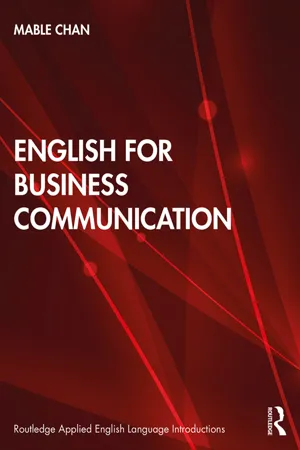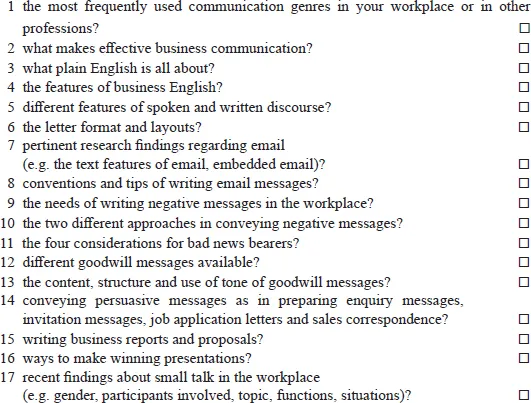
- 236 pages
- English
- ePUB (mobile friendly)
- Available on iOS & Android
eBook - ePub
English for Business Communication
About this book
This textbook provides a comprehensive introduction for students and professionals who are studying English for business or workplace communication and covers both spoken and written English.
Based on up-to-date research in business communication and incorporating an international range of real-world authentic texts, this book deals with the realities of communication in business today. Key features of this book include:
- use of English in social media that reflects recent trends in business communication;
- coverage of the concept of communicative competence;
- analysis of email communication;
- introduction to informal English and English for socialisation as well as goodwill messages, such as thank you or appreciation messages, which are a part of everyday interaction in the workplace;
- examination of persuasive messages and ways to understand such messages;
- an e-resources website that includes authentic examples of different workplace genres and a reference section covering relevant research studies and weblinks for readers to better understand the topics covered in each chapter.
This book goes beyond the traditional coverage of business English to provide a broad and practical textbook for those studying English in a workplace setting.
Frequently asked questions
Yes, you can cancel anytime from the Subscription tab in your account settings on the Perlego website. Your subscription will stay active until the end of your current billing period. Learn how to cancel your subscription.
No, books cannot be downloaded as external files, such as PDFs, for use outside of Perlego. However, you can download books within the Perlego app for offline reading on mobile or tablet. Learn more here.
Perlego offers two plans: Essential and Complete
- Essential is ideal for learners and professionals who enjoy exploring a wide range of subjects. Access the Essential Library with 800,000+ trusted titles and best-sellers across business, personal growth, and the humanities. Includes unlimited reading time and Standard Read Aloud voice.
- Complete: Perfect for advanced learners and researchers needing full, unrestricted access. Unlock 1.4M+ books across hundreds of subjects, including academic and specialized titles. The Complete Plan also includes advanced features like Premium Read Aloud and Research Assistant.
We are an online textbook subscription service, where you can get access to an entire online library for less than the price of a single book per month. With over 1 million books across 1000+ topics, we’ve got you covered! Learn more here.
Look out for the read-aloud symbol on your next book to see if you can listen to it. The read-aloud tool reads text aloud for you, highlighting the text as it is being read. You can pause it, speed it up and slow it down. Learn more here.
Yes! You can use the Perlego app on both iOS or Android devices to read anytime, anywhere — even offline. Perfect for commutes or when you’re on the go.
Please note we cannot support devices running on iOS 13 and Android 7 or earlier. Learn more about using the app.
Please note we cannot support devices running on iOS 13 and Android 7 or earlier. Learn more about using the app.
Yes, you can access English for Business Communication by Mable Chan in PDF and/or ePUB format, as well as other popular books in Education & Education Theory & Practice. We have over one million books available in our catalogue for you to explore.
Information
Chapter 1
Written and spoken communication in the workplace
Questions for reflection
- 1 What are the spoken and written communication means available in the workplace?
- 2 Which profession are you in? Is spoken or written communication more dominant in your workplace? Why?
- 3 What are the difficulties and challenges you face in spoken and written communication?
Needs analysis
Check the following boxes and determine if you have the following workplace communicative needs, and your familiarity with such topics:
Are you familiar with:


Introduction
Most business English textbooks are organised around traditional business genres of written and spoken communication in the workplace. With the fast development of social media tools and technology, there are so many emerging communication tools that have inevitably changed workplace communication culture. This chapter gives some background information about the latest developments of written and spoken communication in the workplace and highlights the features of each chapter in this book. There are also post-reading activities at the end of the chapter.
For written communication, email has been the primary communication means in the workplace for decades (Dabbish & Kraut, 2006; Fisher, Brush, Gleave, & Smith, 2006; Soucek & Moser, 2010; AlAfnan, 2015; Darics, 2015). Unlike letters and faxes, email allows messages to be sent any time and to anywhere, and it is technically easy to use. While email is still an essential communication means in organisations, there is an emerging trend of alternatives available for communication. These alternatives include instant messaging, wikis, social networking, blogging, micro-blogging, and desktop videoconferencing (Ajjan, Hartshorne, Cao, & Rodriguez, 2014; Kim & Martin, 2013; Johri, 2015; Karis, Wildman, & Mané, 2016; Van der Merwe, 2016; Vuori & Jussila, 2016; Engler & Alpar, 2017). The advantages of using such synchronous means are that they allow knowledge sharing, coordination and collaboration more effectively. The exponential growth in use of social networking in business seems to have also affected the use of spoken communication (Amare & Brammer, 2005; Wang, Pauleen, & Zhang, 2016). Bellman (2000), for example, reported that organisations he examined had reduced their phone usage by 81% by introducing instant messaging software for use by employees.
A number of studies have been conducted to examine the language competency and needs of working professionals from different professions (Evans & Green, 2003; Chew, 2005; Qian, 2005; Evans, 2010; Kassim & Ali, 2010; Spence & Liu, 2013; Chan, 2014; Itani, Järlström, & Piekkari, 2015; Lum, Dowedoff, Bradley, Kerekes, & Valeo, 2015; Gold Veerkamp, Abke, & Diethelm, 2016; Hull, 2016; Knoch, May, Macqueen, Pill, & Storch, 2016; Lin, 2016). The use of spoken communication is found to be particularly important in certain professions such as engineering, banking and nursing. The engineering practice, for example, takes place in an intensely oral culture, and formal presentations are instrumental to practicing engineers. In Kassim and Ali (2010) examining the communication skills required by engineers, engineers rated teleconferencing, social networking and oral presentations as the most important communicative events. Compared to written communication skill, oral communication skill is more important and fluency of the English language is one of the key determinants to succeed in career development. Another study examining the language needs of engineers in Taiwan (Spence & Liu, 2013) found that writing and reading emails, reports and memos as well as meetings, teleconferences and presentations are of high frequency (over 60%) in workplace communication. Findings also showed that engineers’ frequency of using English increased with their rank, and oral English skills are particularly important for customer visits and relationship building. Interviewees who were banking employees in Chew’s (2005) study expressed interest in language training courses with particular interests in spoken English in the areas of presentation skills and English for social interaction and daily use. In line with Chew’s (2005) finding on banking employees’ interests in improving spoken English for daily communicative events, partcipants in Chan’s (2014) study involving 215 Chinese professionals in Hong Kong also expressed their difficulties with casual conversation and social interaction in English due to a lack of training and practice in this aspect. Another profession in which oral communication has become increasingly essential is health care. As revealed by Lum et al. (2015), while the doctors and nursing staff need to discuss effectively with jargon and technical terms with medical teams, an increasingly diverse patient population nowadays also requires them to communicate engagingly with plain language in order to convince the patients to follow through the medication or treatment process.
Outline of the different chapters
The following outlines the different chapters of this book and highlights features of each chapter:
- 1 Written and spoken communication in the workplace
- 2 Features of business communication
- 3 Email and emerging social media for different communicative purposes
- 4 Conveying negative and goodwill messages
- 5 Persuasive messages: Sales correspondence and job applications
- 6 Persuasive messages: Enquiry and invitation messages
- 7 Formal business reports/proposals
- 8 Making oral presentations
- 9 Socialisation
- 10 Business meetings and negotiations
- 11 Employment and appraisal interviews
- In Chapter 2, read...
Table of contents
- Cover
- Half Title
- Series
- Title
- Copyright
- Dedication
- Contents
- Acknowledgements
- 1 Written and spoken communication in the workplace
- 2 Features of business communication
- 3 Email and emerging social media for different communicative purposes
- 4 Conveying negative and goodwill messages
- 5 Persuasive messages: Sales correspondence and job applications
- 6 Persuasive messages: Enquiry and invitation messages
- 7 Formal business reports/proposals
- 8 Making oral presentations
- 9 Socialisation
- 10 Business meetings and negotiations
- 11 Employment and appraisal interviews
- Index